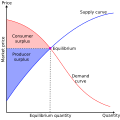Talk:Maximum theorem
| This article is rated C-class on Wikipedia's content assessment scale. It is of interest to the following WikiProjects: | ||||||||||||||||||||||||||||||||||
| ||||||||||||||||||||||||||||||||||
Could someone please edit this article to define "compact-valued correspondence" and the meaning of the double-arrow-point??? Otherwise the article is just technobabble. 98.155.236.135 (talk) 19:06, 28 July 2014 (UTC)
Error in theorem statement
editIf I am not completely mistaken, then the continuity of C at theta only guarantees f* to be continuous at theta and C* to be upper hemicontinuous and compact valued at theta, not globally. 120.51.141.38 (talk) 05:04, 19 May 2023 (UTC)
Possible error?
editUnder "Variants and generalizations", the article states:
"If is concave and has a convex graph, then is concave and is convex-valued. Similarly to above, if is strictly concave, then is a continuous function."
I believe this is incorrect... shouldn't f* be convex rather than concave ? Consider a simple example where for a strictly convex set . Then has a convex graph and f is linear (and hence concave). However, let now , and . Then ,
which implies convexity, not concavity. Shysquirrel (talk) 09:50, 20 December 2024 (UTC)
- I don't understand how f* in the proposed counterexample is a value function (in the sense of Maximum theorem#Statement of theorem) Saung Tadashi (talk) 22:24, 23 December 2024 (UTC)
- My bad, I should have written f*= max (or sup), not arg max. The argmax is z* in the example. Shysquirrel (talk) 08:20, 24 December 2024 (UTC)
- I think I got the problem. In the cited reference (Sundaram, Rangarajan K. (1996). A First Course in Optimization Theory. Cambridge University Press. p. 237. ISBN 0-521-49770-1) it states that f should be concave in . While f is linear in and in , f is not linear in the Cartesian product. Does it make sense? Saung Tadashi (talk) 17:47, 24 December 2024 (UTC)
- Oh I see. Thanks for clarifying! I tried looking up the reference but do not have access to it – and did not read the statement carefully enough. Shysquirrel (talk) 08:34, 27 December 2024 (UTC)
- I think I got the problem. In the cited reference (Sundaram, Rangarajan K. (1996). A First Course in Optimization Theory. Cambridge University Press. p. 237. ISBN 0-521-49770-1) it states that f should be concave in . While f is linear in and in , f is not linear in the Cartesian product. Does it make sense? Saung Tadashi (talk) 17:47, 24 December 2024 (UTC)
- My bad, I should have written f*= max (or sup), not arg max. The argmax is z* in the example. Shysquirrel (talk) 08:20, 24 December 2024 (UTC)



